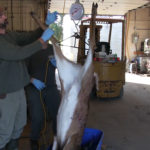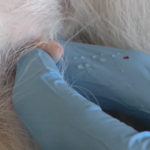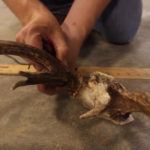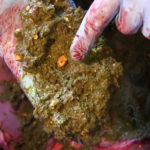 Purdue University - Extension - Forestry and Natural Resources
Purdue University - Extension - Forestry and Natural Resources
Got Nature? Blog
Six pieces of data to collect from deer you harvest this year
Deer season is upon us in Indiana! If you are a serious hunter and deer manager, here are some things you should consider collecting from deer you harvest. This data provides valuable insights to the deer herd condition, and when combined with hunter observation data and habitat data, like browse transects, you can get a clear picture of the deer herd and habitat quality on your property. However, one year of harvest data is unlikely to be much of value, but collecting data over multiple years can help you track trends in the herd and habitat quality.
What to collect
When you harvest a deer on your property you should consider collecting the following pieces of biological information:
- Sex
- Age
- Weight
- Lactation status
- Antler measurements
- Rumen contents
*Each deer you harvest should be assigned a unique ID number to be sure all the following data is assigned to the right deer.
Sex and Age
Collecting deer sex and age (based on tooth replacement and wear) can help you divide the rest of the data you collect into sex and age classes. Find out how to determine age by viewing Age Determination in White-Tailed Deer video. You do not  necessarily have to age a deer to the exact year, but you should separate ages into at least 3 age classes; fawns, yearlings, and >= 2.5 years old. This can be important for tracking changes to the average weight per age class or average antler measurements per age class over time.
necessarily have to age a deer to the exact year, but you should separate ages into at least 3 age classes; fawns, yearlings, and >= 2.5 years old. This can be important for tracking changes to the average weight per age class or average antler measurements per age class over time.
Weight
You can collect either live weights or dressed weights, but you should pick one or the other and collect all weights consistently. Be sure to test your scales for accuracy before weighing deer. Tracking changes to the average weight per age class can provide  information about the nutritional status of the herd.
information about the nutritional status of the herd.
Lactation Status
Lactation status of does is often used as an index of fawn recruitment and can help determine if a doe had a fawn the summer preceding the hunting season. Lactation status for does harvested early in the season can be checked by squeezing the teats to produce milk you may need to cut into the mammary gland on does harvested later in the season to check lactation status.
Antler measurements
Antler measurements should be collected from bucks harvested on your property, including yearlings. Find out how to measure the antlers by viewing How to Score Your White-Tailed Deer video. At a minimum, you should collect the number of points on each antler and the basal circumference of the main beams. You may also consider collecting the inside spread of the antlers and the main beam lengths. Additionally, you can collect the gross Boone & Crockett Score.
Rumen contents
 This piece of data can be helpful from a scouting and hunting aspect. Looking into the rumen of a deer can help you determine what deer may be eating during the portion of the year the deer was harvested. You may find green material (which can be hard to identify), corn, acorns, or whatever else deer may be consuming.
This piece of data can be helpful from a scouting and hunting aspect. Looking into the rumen of a deer can help you determine what deer may be eating during the portion of the year the deer was harvested. You may find green material (which can be hard to identify), corn, acorns, or whatever else deer may be consuming.
Things you need to collect harvest data
Here is a list of items you might need to collect data from harvested deer.
- Jawbone extractor
- Knife
- Loppers
- Scale
- Jawbone tag or permanent marker
- Flexible measuring tape
- Datasheet (click here for a white-tailed deer harvest datasheet)
Putting all of this data together can give you a picture into the condition of the deer herd on your property. Collecting this data only takes a small amount of time and effort and the information you gather is well worth it! For more information of how to collect biological data from harvested deer, check out this video from Purdue Extension.
Help the Indiana Department of Natural Resources (IDNR) collect biological data from harvested deer
Most of the data we discussed in this blog post and that is covered in the White-Tailed Deer Post Harvest Collection video, are data the Indiana DNR is collecting through an online post-harvest survey. This is a great opportunity for hunters to help the DNR collect data that will be used to manage the deer herd throughout the state. More information about the after the hunt survey can be found by visiting the Indiana DNR Deer After Hunt Survey page. If you are successful in harvesting a deer in Indiana this year, be sure to check your email for a link to the survey.
Additional Resources:
Age Determination in White-Tailed Deer video, Purdue Extension – FNR YouTube Playlist
How to Score Your White-Tailed Deer video, Purdue Extension – FNR YouTube Playlist
White-Tailed Deer Post Harvest Collection video, Purdue Extension – FNR YouTube Playlist
White-Tailed Deer Harvest Log (pdf), Purdue Extension-FNR
Indiana Deer Hunting, Biology and Management, Indiana Department of Natural Resources (IDNR)
Indiana Hunting and Trapping Guide, Indiana Department of Natural Resources (IDNR)
Managing White-Tailed Deer: Collecting Data from Harvested Deer, Alabama Cooperative Extension System
Jarred Brooke, Wildlife Extension Specialist
Department of Forestry & Natural Resource, Purdue University

Recent Posts
- Publication – Goldenrod Control
Posted: April 30, 2025 in Forestry, Invasive Plant Species, Wildlife - White-tailed Deer Impact on Indiana Woodlands, Hoosier Ag Today
Posted: April 29, 2025 in Wildlife, Woodlands - Top 10 Spring Flowering Shrubs, Purdue Landscape Report
Posted: April 28, 2025 in Gardening, Plants, Urban Forestry - HTIRC Continues to Protect Our Hardwood Forests
Posted: April 18, 2025 in Forestry, Timber Marketing, Woodlands - Tips to Manage Storm-Damaged Trees, Purdue Landscape Report
Posted: April 17, 2025 in Forests and Street Trees, How To, Urban Forestry - Liz Jackson Receives IHLA’s President’s Award, Featured in ANR Newsletter
Posted: in Forestry, Timber Marketing, Wildlife, Wood Products/Manufacturing, Woodlands - A Woodland Management Moment: Bottomland Forests
Posted: in Forests and Street Trees, Urban Forestry, Wildlife, Woodland Management Moment, Woodlands - When is the Peak Migration For Hummingbirds and How Can You Attract Them?
Posted: April 4, 2025 in How To, Wildlife - Smooth Patch of Oak – Purdue Landscape Report
Posted: March 27, 2025 in Forests and Street Trees, Urban Forestry, Wildlife, Woodlands - Prepared for Insects Waking Up? – PLR
Posted: March 26, 2025 in Forestry, Invasive Insects, Urban Forestry, Wildlife
Archives
Categories
- Alert
- Aquaculture/Fish
- Aquatic/Aquaculture Resources
- Ask the Expert
- Christmas Trees
- Community Development
- Disease
- Drought
- Forestry
- Forests and Street Trees
- Gardening
- Got Nature for Kids
- Great Lakes
- How To
- Invasive Animal Species
- Invasive Insects
- Invasive Plant Species
- Land Use
- Natural Resource Planning
- Nature of Teaching
- Plants
- Podcasts
- Ponds
- Publication
- Safety
- Spiders
- Timber Marketing
- Uncategorized
- Urban Forestry
- Webinar
- Wildlife
- Wood Products/Manufacturing
- Woodland Management Moment
- Woodlands